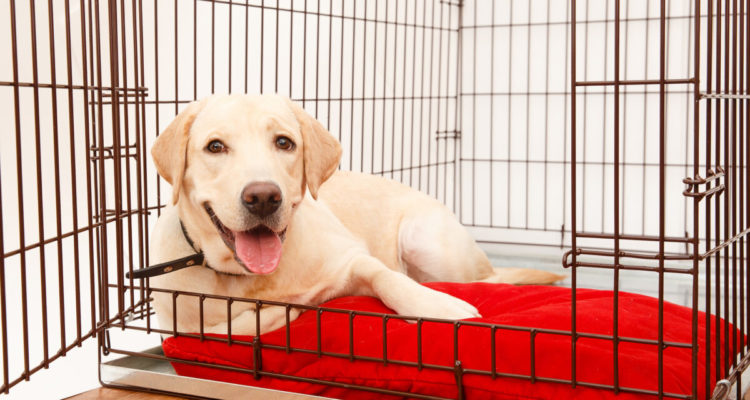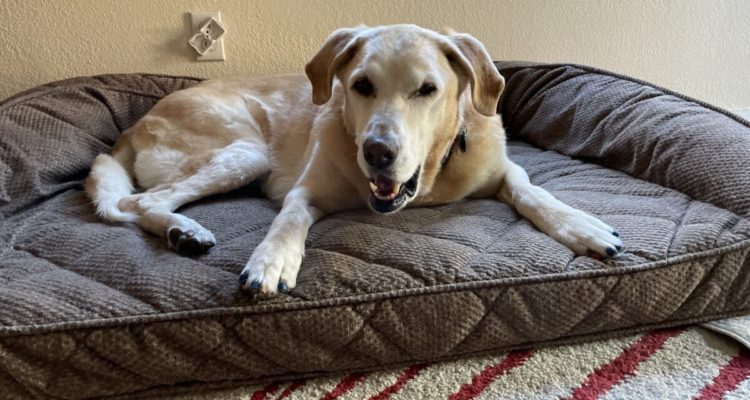Reading Time: 4 minutes It’s an immense privilege to have loved my Lab mix, Rio, for over…

Welcome Home: How to Crate Train Your New Dog or Puppy
 Reading Time: 3 minutes
Reading Time: 3 minutes
You’ve just brought your new dog or puppy home. It’s been a big day and it’s time to give everyone a break. After all, there’s dinner to prepare for the humans, laundry to do, errands to run, and your favorite TV show comes on at 8, but don’t forget about that new dog.
A dog or puppy left unattended to roam around your house is an invitation for trouble. Not only could this result in damage to a favorite piece of furniture, it could result in your dog getting hurt or sick. When you can’t supervise your new dog, it should be in a crate.
Crate training is one of the easiest ways to help your new dog be successful in your home. It is not cruel to put your dog in a crate. In fact, most veterinarians and breeders recommend crate training your dog from the puppy stage up through the senior years. Crates provide a den-like, safe space to contain your dog when you’re not home and when you are busy with kids or other daily life happenings.
Plus, just like you, your dog needs a quiet place they can go when they need to decompress and get away from the hustle and bustle of your household. Remember to teach children that the dog’s crate is off limits. That’s where the dog goes to have some quiet time and they need to respect that. When the dog wants to play, he will come out and find your kids.
We always want the crate to be a positive place, so here’s a list of 10 dos and don’ts for crate training your dog:
- Give your dog a food dispensing toy in their crate.
- Try feeding your dog its meals in the crate in the first few days, as he’s getting used to it. Your dog will love to eat and eating in the crate makes the crate a pleasurable experience.
- Line the bottom with a soft blanket or mat.
- Place a toy inside the crate for your dog to play with.
- Reward your puppy with a food treat and lots of praise every time they go in the crate.
- Associate a single word, like “crate,” to the act of your dog going in its crate. Always follow with a treat and lots of praise. Make sure everyone in your household uses that word, and only that word.
- Don’t use the crate as punishment. You want the crate associated with good things, not bad ones.
- Don’t leave your new puppy or dog in the crate all day. He will need bathroom breaks, play breaks, and feeding breaks, throughout the day.
- Remember patience and consistency. Each dog learns at their own pace and it might take awhile for your dog to get the hang of going into their crate on command and laying down quietly.
- Always take your new puppy to the bathroom each time you take them out of their crate.
Another great side benefit of crate training your dog is housetraining. We’ll talk about the ins and outs of housetraining in our next segment, but dogs won’t want to pee or poo where they sleep. Crates can really help you manage where your dog is learning to go to the bathroom in the first two weeks of being home. Crates can also help you to manage dogs that are going through excessive chewing phases.
So now that you understand why your dog needs a crate, you may be asking, what kind of crate should I get that behemoth Newfoundland puppy that is twelve weeks old and already 40 lbs.?
- Choose a well-ventilated crate that is just large enough for your dog or puppy to comfortably turn around in and not much larger. (For puppies, look for crates that have a built-in divider that can be adjusted as your puppy grows. This is more common in wire crates.)
- Hard sided crates are made for easy transport of your dog, so if you’re going to be traveling, or if you want a safe way to get your dog to the vet and the groomer, a hard sided crate is a good idea.
- Soft-sided crates are easy to transport and set up anywhere, but may not be suitable for a new puppy or dog just learning the ropes of crate training. My Newfoundland was 3 years old and ate the side out of her soft-sided crate. Which brings about the point that each dog is an individual and what works for one, might not work for another. So, the moral of this story is, revisit the soft-sided crate after you master crate training.
Crate training can help minimize the stress your dog will go through in the first days and weeks of being in a new home. Expect a little whining or crying the first couple of days, but stay strong, and know that your dog’s crate is really the safest place for your dog to be at night or when you’re not supervising.
If you have any questions about crate training, be sure and ask your veterinarian. Your dog’s vet is a great resource for behavioral and training issues, including crate training.
This article was reviewed/edited by board-certified veterinary behaviorist Dr. Kenneth Martin and/or veterinary technician specialist in behavior Debbie Martin, LVT.
Source: https://www.fearfreehappyhomes.com/welcome-home-how-to-crate-train-your-new-dog-or-puppy/


